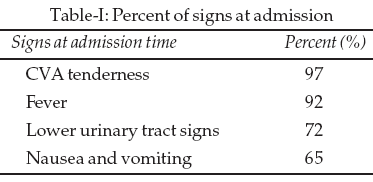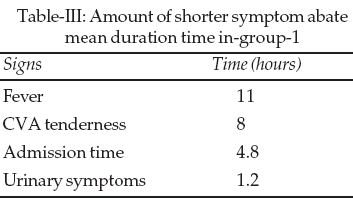|
 |
|
Published
by : PROFESSIONAL MEDICAL PUBLICATIONS |
|
ISSN 1681-715X |
|
|
|
|
|
- |
|
ORIGINAL
ARTICLE |
|
- |
|
Volume 24 |
October - December 2008
(Part-II) |
Number 6 |
|
|
|
Comparison between Cephalothin and
Ampicillin + Gentamicin in treatment
of pyelonephritis in pregnancy
Moramezi F1, Barati M 2, Masihi S3
ABSTRACT
Objective: Urinary tract infection is a common
problem in pregnancy and its complications affect both pregnant woman and her
fetus. Different treatment strategies have been suggested and some of them are
less safe. This study compared the effectiveness of cephalothin treatment with
ampicillin + gentamycin protocol.
Methodology: Sixty pregnant patients with
pylonephritis in Imam Khomeini and Razi hospitals in Ahwaz were randomized in
two groups of 30 patients, one with cephalothin only treatment and the other
with ampicillin+gentamycin. Both groups were compared in term of duration of
fever, CVA tenderness, symptoms and length of stay in hospital.
Results: Cephalothin only group had less duration
of fever, approximately eleven hours, which was statisticaly significant.
Length of stay and symptoms’ relief were also less in cephalothin only group
but it had no statistical significance.
Conclusion: Cephalothin is a safe and effective
remedy in the treatment of pyelonephritis in pregnancy and may be used as the
first choice treatment even in severely ill patients.
KEY WORDS: UTI, Pregnancy, Cephalothin.
Pak J Med Sci October - December 2008
(Part-II) Vol. 24 No.6 865-868
How to cite this article:
Moramezi F, Barati M , Masihi S. Comparison between Cephalothin and
Ampicillin+Gentamicin in treatment of pyelonephritis in pregnancy. Pak J Med
Sci 2008;24(6):865-68.
1. Moramezi F. MD
Assistant Professor of Obs & Gyn Department,
Razi Hospital,
Ahwaz - Iran.
2. Barati M. MD
Assistant Professor of Obs & Gyn Department,
Imamkhomeini Hospital,
Ahwaz - Iran.
3. Masihi S. MD
Assistant Professor of Obs & Gyn Department,
Razi Hospital,
Ahwaz - Iran.
Correspondence
Mojgan Barati
E-mail: brati_m@yahoo.com
* Received for Publication: April 9, 2008
* Accepted: September 6, 2008
INTRODUCTION
Renal infection is a common medical disorder occurring in
approximately 2% of pregnant women.
1
Thirty three percent of these women may have a recurrence during the same
pregnancy.2
Other studies show that in pregnant women, the incidence of UTI can be as high
as 8 percent.3,4
Dilatation of pyelocaliceal system and pressure effect of pregnancy
predisposes pregnant women to urinary tract infection.1
Another factor that increases the rate of infection is due to increased
vesicoureteral reflux. Acute pyelonephritis is the leading cause of septic
shock during pregnancy. The population incidence of renal infection varies and
depends on the prevalence of covert bacteriuria and whether it is treated.
Acute pyelonephritis predisposes pregnant women to sever complications like
preterm labor, transient renal failure, ARDS, sepsis, shock and hematological
disturbances.5
Asymptomatic bacteriuria may predispose
the patients and their fetuses to preterm labor and Low Birth Weight of Fetus.6
Neonatal outcomes that are associated with UTI include
sepsis and pneumonia (specifically, group B streptococcus infection).
7,8
Different treatment strategies were suggested and some of them had lesser
safety. Historically, ampicillin has been the drug of choice, but in recent
years E. coli has become increasingly resistant to ampicillin.9
Ampicillin resistance is found in 20 to 30 percent of E. coli cultured
from urine in the outpatient setting.10
In other studies Ampicillin resistance is reported about 46%.11
Ceftriaxone is an expensive drug. In reference the choice of drug is empirical
and ampicillin plus gentamycin, cephalothin or ceftriaxon could be used. A
randomized study of 90 obstetric inpatients with pyelonephritis compared
treatment with oral cephalexin to treatment with intravenous cephalothin (Keflin)
and found no difference between the two groups in the success of therapy,
infant birth weight or preterm deliveries.12
Cephalothin only and ampicillin + gentamycin regimen have low cost.
Aminoglycoside must be added to ampicillin and serial
determination of serum creatinine is important if this nephrotoxic drug given.
In 1-2% of patients 8
th
nerve toxicity is reported by gentamycin.1
The neurotoxic effects are variable from long life hearing
loss to tinitus and ataxia. Selection of one antibiotic is difficult. There
are a lot of drugs with different outcome and different side effects. If two
or more drugs have the same efficacy, the drug with lesser toxicity is
preferred. When selecting a drug for treatment, the point which must be
considered are drug efficacy, drug toxicity, shorter duration, dosage and low
cost of drug.
13
Because of these reasons we compared the efficacy of two
regimens of cephalothin and ampicillin +gentamycin in the treatment of
pyelonephritis in pregnancy.
METHODOLOGY
This prospective study was conducted on pregnant women with
pyelonephritis in Imam Khomeini and Razi hospital in Ahvaz from Jan. 2002 to
Jan. 2004. The 60 patients were studied in two randomized groups of 30
patients. Group one was treated by cephalothin one gram intravenous every six
hours and group two was treated by ampicillin one gram intravenous every six
hours + gentamycin 80 mg intravenous every eight hours until cessation of
fever and then changed the drug to cephlexin 500 mg every six hours by oral
root in both groups. The time of discharge was 24 hours after cessation of
fever.
Information which was collected at the first visit by
questionnaire, include: age, parity, gestational age, temperature, urinary
symptoms, flank pain, presence of nausea and vomiting. Additional information
gathered during evaluation and treatment included duration of becoming
afebrile, signs’ of recovery and improvement. Patients with positive clinical
signs and negative urine culture weren’t included in the study.
RESULTS
Eighty three percent of patients were primiparus and 17%
were multiparas. Fifty seven percent were in their second trimester, 15% in
first trimester and 28% in third trimester. The most common symptoms at first
visit was flank pain (57%) followed by chills and fever (48%) and lower urinay
tract symptome (13%) shown in Table-I.

Ninety five percent pyuria and 19% nitrate positive were
found in patients’ urine analysis. E/coli were isolated from the urine in 91%
and Klebsiella in 9%. Laboratory sensitivity test detected ampicillin
resistance in 68%, cephalothin resistance 40%, gentamycin resistance 18% and
ceftriaxone resistance in 0%. Persistence fever was the cause of change of
drug treatment in 5% of patients.

Mean body temperature in Group-1 was 38.51 and 38.3 in the
other group before beginning the treatment. The duration of clinical
improvement is shorter in Group-1 (Tables-II&III).

Discussion
As discussed before the mean body temperature in Group-1
before initiation of the treatment was slightly more than the other
group(38.53 versus 38.51) but the afebrile time in Group-1 approximately 11
hours was shorter than the 2
nd
group(p value=0.01). Mean length of CVA tenderness and urinary symptom in
cephalotin’s group 8 hours and 1.2 hours was less than group two respectively
(p value=0.07), but not statistically significant.
Hospital stay in Group one was 4.8 hours less than group
two but with no statistical meaning (P value=0.22). Most patients’ in this
study had flank pain followed by fever and chills. CVA tenderness were found
in 71% of patients at right side, 22% bilateral and only 7% at left side.
Nitrate positive was found in few patients, hence negative urine analysis isn’t???
against diagnosis of pyelonephritis. In the present study E/coli was isolated
in 91% and Klebsiela in 9% versus parkland hospital in which Ecoli was
isolated in 77%, Klebsiela in 11% and proteus in 4%.
14,15
Ampicillin resistance in this study was found in 68%, cephalosporin resistance
in 40%, gentamycin resistance in 18% and ceftriaxon resistance in 0% when
compared with reference in which ampicillin resistance rate is 46 %.11
Persistence fever was the cause of change of antibiotic in 5% of patients.
Response to treatment in both groups was 95%.
CONCLUSION
The result of present study shows that cephalothin therapy
is a good remedy as a first choice in the treatment of pyelonephritis in
pregnancy even in severely ill patients.
REFERENCES
1. Cunningham FG. Renal and urinary tract disorders.
Williams Obstetrics, 21st ed. U.S.A: MC Graw Hill company 2001;1253
2. Gilstrap LC, Cunningham FG, Whalley PJ. Acute
pyelonephritis in pregnancy: an anterospective study. Obstet Gynecol
1981;57:409-13.
3. Patterson TF, Andriole VT. Bacteriuria in pregnancy.
Infect Dis Clin North Am 1987;1:807-22.
4. Mikhail MS, Anyaegbunam A. Lower urinary tract
dysfunction in pregnancy: a review. Obstet Gynecol Surv 1995;50:675-83.
5. Gilstrap LC, Ramin SM. Urinary tract infection during
pregnancy. Obstet Gynecol Clin North Am 2001:28(3):581-91.
6. Smail F. Antibiotic for asymptomatic bacteriuria in
pregnancy. Cochrane database Sust Rev 2001;(2):CD000490.
7. Hart A. Ampicillin resistant Escherichia Coli in
gestation pyelonephritis. J Infec Dis 2001;15:183(10)1526-9.
8. Mead PJ, Harris RE. The incidence of group B beta
hemolytic streptococcus in antepartum urinary tract infections. Obstet Gynecol
1978;51:412-4.
9. Peddie BA, Bailey RR, Wells JE. Resistance of urinary
tract isolates of Escherichia coli to cotrimoxazole, sulphonamide,
trimethoprim and ampicillin: An 11-year survey. N Z Med J 1987;100:341-2.
10. Sanders CC, Sanders WE Jr. Beta-lactam resistance in
gram-negative bacteria: global trends and clinical impact. Clin Infect Dis
1992;15:824-39.
11. Wood EG, Dillon HC Jr. A prospective study of group B
streptococcal bacteriuria in pregnancy. Am J Obstet Gynecol 1981;140:515-20.
12. Angel JL, O’Brien WF, Finan MA, Morales WJ, Lake M,
Knuppel RA. Acute pyelonephritis in pregnancy: a prospective study of oral
versus intravenous antibiotic therapy. Obstet Gynecol 1990;76:28-32.
13. Mandell G, Bennett JE, Mandell DR. Principles and
practice of infectious Disease, 5th ed, Churchill Livingstone Philadelphia
2000;3:770.
14. Cunningham FG. Urinary tract infections complicating
pregnancy. Clin Obstet Gynecol 1988;1:891.
15. Millar Lk, Wing DA, Paul RH Grimes DA. Out patient treatment of
pyelonephritis in pregnancy: A randomized controlled trial. Obstet
Gynecol 1995;86:560.
HOME
| SEARCH
| CURRENT
ISSUE | PAST
ISSUES
Professional
Medical Publications
Room No. 522, 5th Floor, Panorama Centre
Building No. 2, P.O. Box 8766, Saddar, Karachi - Pakistan.
Phones : 5688791, 5689285 Fax : 5689860
pjms@



